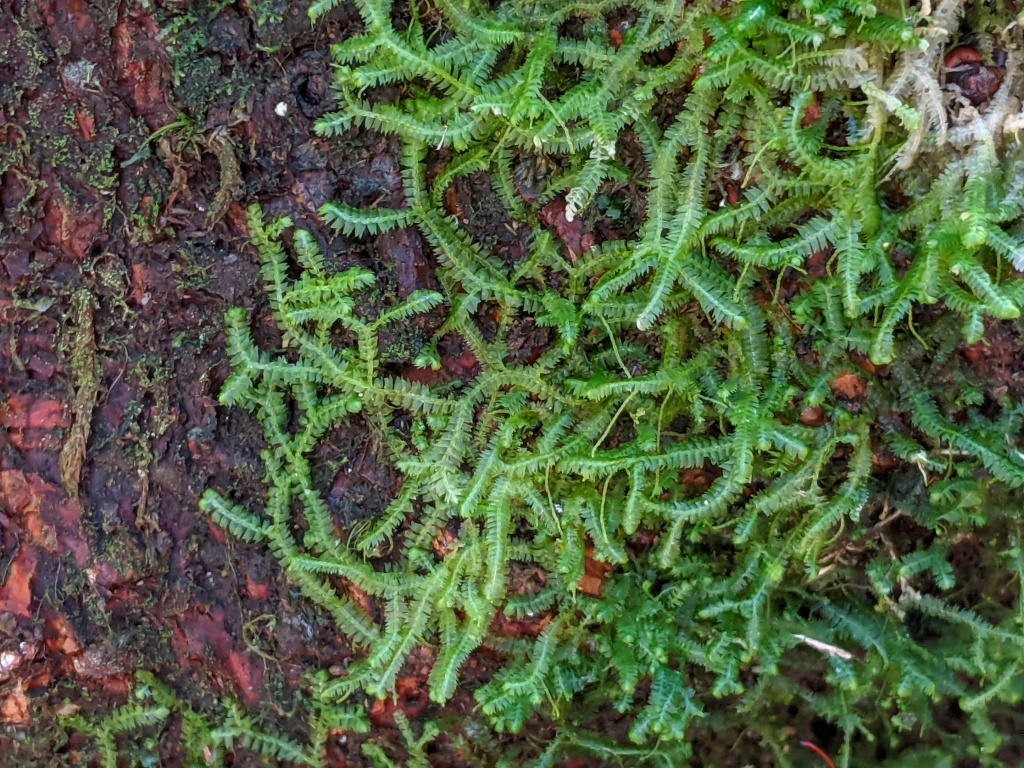Acromastigum
Epiphytic, on logs, lithophytic (not in Victoria) or terrestrial (not in Victoria), dioecious. Asexual reproduction rarely by caducous leaves and underleaves. Stems prostrate or ascending (not in Victoria), dichotomously branched, with two ranks of lateral leaves and a single rank of underleaves; branches emerging laterally from main stem abaxial to unlobed lateral leaf or from beside a narrower underleaf, usually with fewer lobes, and without a collar of tissue at base, or emerging from main stem near unmodified underleaf and with a collar of tissue at base, those of the last type only with much smaller leaves. Lateral leaves ovate or lingulate (not in Victoria) in outline, symmetric (not in Victoria) or asymmetric, unlobed (not in Victoria), 2-lobed, or (not in Victoria) 2–3-dentate-lobulate at apex, sometimes with an additional teeth along the acroscopic margin (not in Victoria), succubous (not in Victoria), transverse (not in Victoria) or incubous, alternate, imbricate to contiguous, widely spreading, convex to concave (not in Victoria) adaxially, collectively green or brownish (not in Victoria), unistratose; lobes equal or unequal, triangular to linear-lingulate (not in Victoria) or linear (not in Victoria), acute. Underleaves much smaller than lateral leaves, quadrate, oblong or ovate (not in Victoria) in outline, undivided (not in Victoria) or 2- (not in Victoria) or 3-lobed, distant; lobes oblong to ovate, rounded to obtuse or retuse, entire or bidentate (not in Victoria), often terminated by a hyaline papilla. Leaf cells irregular (not in Victoria), quadrate, oblong, circular or polygonal, similar throughout leaf or becoming conspicuously larger and more elongate toward acroscopic margin (not in Victoria), smooth or verruculose, firm- to thick- (not in Victoria) walled, with (not in Victoria) or without distinct trigones, without or with 1–16 spherical to ovoid and homogenous, or (not in Victoria) granular- or coarsely botryoidal oil bodies. Rhizoids mostly on microphyllous branches from underleaf and latera leaf bases, rarely on normal leafy stems from underleaf bases. Androecia small branches emerging from near underleaves or from microphyllous branches, with up to 6 pairs of leaf-like but more ventricose bracts, each with a single antheridium. Sporophytes on short branches emerging abaxially from main stem, with 2–3 series of bracts. Perianth fusiform, terete at base, becoming trigonous toward mouth; mouth 3-lobed, laciniate to ciliate. Capsule oblong-ovoid, 2–4-stratose; elaters bispiral. Spores spherical, minutely verruculose, green.
44 species shared between South Africa, Nepal through Malesia to the tropical Pacific, southern South America, New Zealand and eastern Australia (Schuster 2000; Söderström et al. 2016); one species, A. colensoanum (Mitt.) A.Evans ex Reimers, in Victoria.
Schuster, R.M. (2000). Austral Hepaticae Part I. Nova Hedwigia Beiheft 118. Cramer in der Gebrüder Borntraeger Verlagsbuchbehandlung: Berling & Stuttgart.
Söderström, L., Hagborg, A., von Konrat, M., Bartholomew-Began, S., Bell, D., Briscoe, L., Brown, E., Cargill, D.C., Costa, D.P., Crandall-Stotler, B.J., Cooper, E.D., Dauphin, G., Engel, J.J., Feldberg, K., Glenny, D., Gradstein, S.R., He, X., Heinrichs, J., Hentschel, J., Ilkiu-Borges, A.L., Katagiri, T., Konstantinova, N.A., Larraín, J., Long, D.G., Nebel, M., Pócs, T., Puche, F., Reiner-Drehwald, E., Renner, M.A.M., Sass-Gyarmati, A., Schäfer-Verwimp, A., Moragues, J.S., Stotler, R.E., Sukkharak, P., Thiers, B.M., Uribe, J., Váňa, J., Villarreal, J.C., Wigginton, M., Zhang, L. & Zhu, R. (2016). World checklist of hornworts and liverworts. Phytokeys 59: 1–828.
 Spinning
Spinning